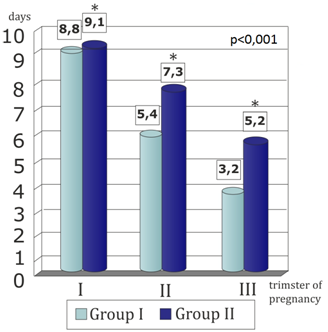МОЖЕТ ЛИ ХОДЬБА И РЕЛАКСАЦИЯ ПОМОЧЬ БЕРЕМЕННЫМ ЖЕНЩИНАМ ИЗБЕЖАТЬ МИГРЕНОЗНЫЙ ПРИСТУП?
Деревянко Х.П.1, Исмагилова А.Ф.2
1Кандидат медицинских наук, невролог Клиники Башкирского государственного медицинского университета, 2Интерн отделения неврологии, нейрохирургии с курсом медицинской генетики, Башкирский государственный медицинский университет
МОЖЕТ ЛИ ХОДЬБА И РЕЛАКСАЦИЯ ПОМОЧЬ БЕРЕМЕННЫМ ЖЕНЩИНАМ ИЗБЕЖАТЬ МИГРЕНОЗНЫЙ ПРИСТУП?
Аннотация
Данная статья поможет выяснить, влияет ли использование немедикаментозного лечения на течение приступов мигрени у беременных женщин. Ключевые слова: беременность, мигрень, немедикаментозное лечение.Derevyanko Kh.P.1, Ismagilova A.F.2
1MD, Neurologist at the Clinic of Bashkir State Medical University, 2Intern of Department of Neurology, Neurosurgery & Medical Genetics at the Bashkir State Medical University
CAN WALKING AND RELAXATION AVOID MIGRAINE ATTACKS IN WOMEN DURING PREGNANCY?
Abstract
This article helps to find out non-medical treatment influences on the course of migraine attacks in women during pregnancy Keywords: pregnancy, migraine, non-medical treatment. Introduction Migraine is a common form of primary headaches. Its maximum spread caused by female gonadal hormones influence is noted among women of reproductive age who are able to work [1]. According to clinical studies 60-70 % of women suffering from migraines have significant decrease of migraine attacks during pregnancy especially in the second and third trimesters [2,3,5]. However, the most important issue for general practitioners is the care of pregnant women with migraine attacks without aura persisting during pregnancy. During the observation we noticed that women who use regular walks and relaxation techniques had migraine attacks less often than other pregnant women. Aim To study the influence of relaxation and daily walks on the frequency and intensity of migraine attacks in women during pregnancy Methods The research group consisted of 114 women suffering from migraines in past medical history before pregnancy. Inclusion criteria: pregnancy in women, migraines in past medical history before pregnancy, absence of somatic and psychic diseases, absence of focal neurological symptoms, normal obstetric history, women consent for investigation. The diagnosis was defined in accordance with International Classification of Headache Disorders, 3rd edition (ICHD-3, beta version), criteria [4]. The women were observed during first, second, third trimester of pregnancy. The study included: headache diary, estimation of headache intensity according to visual analogue scale (VAS), anxiety and depression levels according to Beck’s and Spilberger’s scales. Patients were divided into two groups. The first group (Group I): 58 pregnant women preferred relaxation methods and walks for more than four hours and followed all the recommendations (regime, avoidance of food containing tyramine). The second group (Group II): 56 pregnant women didn’t want to use relaxation methods and walked for less than four hours but followed general recommendations for patients with migraines. Results Positive dynamics has been observed during the second and third trimesters in 90% of women who used methods of relaxation and walked for more than 4 hours per day following all general recommendations for patients with migraines resulting in the reduction of headache intensity and the number of attacks for a month (Table 1).Table 1 – Dynamics of headache intensity and migraine attacks number during pregnancy
Complete remission of migraine attacks was fixed in 10% of patients in the first trimester of pregnancy.Fig. 1 - Dynamics of migraine attacks intensity during pregnancy for VAS scale
The women who followed general recommendations only had more frequent attacks with the intensity of migraine pain not lower than 60 points according to VAS (Image 1). Mild anxiety has been registered in these women as well.Fig. 2 - Dynamics of headache intensity and migraine attacks number during pregnancy
Conclusion As a result of our research the following dynamics has been detected: in women suffering from migraines without aura who followed all the recommendations (regime, avoidance of food containing tyramine) the total remission of migraine attacks has been observed. In women with frequent migraine attacks in the past medical history the number of attacks during pregnancy decreased twofold The given research suggests that patients' behavior during pregnancy also plays a key role in the intensity and frequency of migraine attacks. Women who use moderate exercise combined with relaxation methods and general recommendations for patients suffering from migraines experience less intense migraine attack with the lowest frequency. Thus, when planning pregnancy women who suffer from migraines should be instructed of relaxation methods as well as recommendations regarding moderate walking.References
- Allais G, Gabellari IC, Borgogno P, De Lorenzo C, Benedetto C. The risks of women with migraine during pregnancy. Neurological sciences : official journal of the Italian Neurological Society and of the Italian Society of Clinical Neurophysiology. Jun 2010;31 Suppl 1:S59-61.
- Aube M. Migraine in pregnancy. Neurology. 1999;53(4 Suppl 1):S26-28.
- David PS, Kling JM, Starling AJ. Migraine in pregnancy and lactation. Current neurology and neuroscience reports. Apr 2014;14(4):439.
- Headache Classification Committee of the International Headache Society (IHS) (2013) The International Classification of Headache Disorders, 3rd edition (beta version). Cephalalgia 33:629-808.
- Nappi RE, Albani F, Sances G, Terreno E, Brambilla E, Polatti F. Headaches during pregnancy. Current pain and headache reports. Aug 2011;15(4):289-294.



